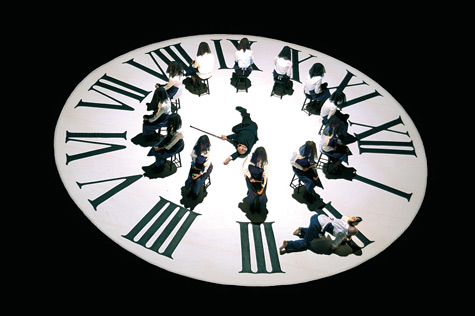
The army, the circus and the restaurant: three diverse institutions, each embodying distinct ideas about the nature of service. In Killing Time, Hungarian installation artist Balázs Kicsiny both investigates and conflates these institutions and their raisons d’être — to protect or kill, to entertain and to feed — immersing viewers in fragmentary, disquieting and sometimes absurdist narratives that challenge assumptions about who is serving whom, and to what purpose.
In January, the Mildred Lane Kemper Art Museum at Washington University in St. Louis will present Balázs Kicsiny: Killing Time, Kicsiny’s newest installation and his first U.S. museum exhibition, developed while in-residence last spring with the Sam Fox School of Design & Visual Arts.
As the Henry L. and Natalie E. Freund Visiting Artist, Kicsiny spent two months co-teaching a class on the performative aspects of contemporary practice, while also engaging students in the fabrication of components for the installation. The class was led in collaboration with Robert Gero, lecturer in the Sam Fox School, who also serves as curator for the exhibition.
Seemingly poised on the edge of violence, Killing Time is anchored by two pairs of life-sized figures. In the first, a male figure, dressed as a chef, stands with knives in hand, facing a female figure dressed as a waitress and strapped to a spinning disk. Both wear military helmets outfitted with small video cameras, their faces covered in identical checkerboard head stockings.
The second pair, wearing similar headgear, are seated nearby and gaze downward at a table of video monitors. Overlooking both scenes is a large circular form, mounted high on a gallery wall, into which knives have been thrown to create a pattern of clock arms and numbers.
“These scenes taken together may evoke an unsettling sense of disorientation or unease in the viewer, since they create a fragmented narrative, a puzzle of sorts, with no fixed meanings,” Gero says. “The protagonists are caught in a frozen performance, a moment of some strange, nonrational event, a dichotomy of perpetual motion and immobility.
“The title, Killing Time, alludes less to violence than to a play with the concept of time and time-consciousness,” Gero adds. “Kicsiny visualizes on one hand Aristotle’s connection between time and motion — that is, objective time, time as the means by which the motion of objects through space is measured. Here every moment is a process, a going-by. In this installation, Kicsiny has slowed the infinite succession to a standstill, freeing the notion of time from a subjugation to the concept of space.
“In doing so, he introduces another reading of ‘killing time’ as a form of timelessness. By stretching a present moment, these captured scenes fold time back onto itself as infinitesimal movement, not so much stillness as durational slowness.”
In conjunction with the exhibition, Kicsiny will lecture about his work Jan. 30 for the Sam Fox School Public Lecture Series. See below for details.
Balázs Kicsiny
One of Hungary’s most highly regarded contemporary artists, Kicsiny is known for creating large-scale, multimedia installations, or “frozen performances,” that draw on the languages of theater, philosophy and the visual arts.
Born in Salgótarján in 1958, Kicsiny attended the Hungarian Academy of Fine Arts, where he studied painting and mural arts and now lectures.
His work has been featured in four exhibitions at the Hungarian National Gallery; in the 2005 Venice Biennale; in the 2005 Baltic Biennale; and in solo shows in New York, London and throughout Europe. His numerous honors include Hungary’s Munkácsy Award and Eötvös Scholarship as well as grants from the Art Council of England.
Mildred Lane Kemper Art Museum
The Mildred Lane Kemper Art Museum, part of Washington University’s Sam Fox School of Design & Visual Arts, is committed to furthering critical thinking and visual literacy through a vital program of exhibitions, publications and accompanying events. The museum dates back to 1881, making it the oldest art museum west of the Mississippi River. Today it boasts one of the finest university collections in the United States.
Support for Balázs Kicsiny: Killing Time was provided by the Henry L. and Natalie E. Freund Art Endowment Fund, the Sam Fox School’s College and Graduate School of Art and members of the Mildred Lane Kemper Art Museum.
Balázs Kicsiny: Killing Time will open with a reception for the artist from 7 to 9 p.m. Friday, Jan. 27, and will remain on view through April 16. Both the reception and the lecture are free and open to the public.
In addition, Kicsiny will lecture about his work at 6:30 p.m. Monday, Jan. 30, in Steinberg Hall Auditorium as part of the Sam Fox School Public Lecture Series.
The Kemper Art Museum is located immediately adjacent to Steinberg Hall on Washington University’s Danforth Campus, near the intersection of Skinker and Forsyth boulevards. Regular hours are 11 a.m. to 6 p.m. Mondays, Wednesdays and Thursdays; 11 a.m. to 8 p.m. Fridays; and 11 a.m. to 6 p.m. Saturdays and Sundays. The museum is closed Tuesdays.
For more information, call (314) 935-4523 or visit kemperartmuseum.wustl.edu.
|
WHO: Balázs Kicsiny: Killing Time at the Mildred Lane Kemper Art Museum WHAT: Exhibition of Kicsiny’s work WHEN: Jan. 27 to April 16. Opening reception from 7 to 9 p.m. Friday, Jan. 27. WHERE: Mildred Lane Kemper Art Museum, Washington University, near the intersection of Forsyth and Skinker boulevards. HOURS: 11 a.m. to 6 p.m. Mondays, Wednesdays and Thursdays; 11 a.m. to 8 p.m. Fridays; 11 a.m. to 6 p.m. Saturdays and Sundays. Closed Tuesdays. COST: Free and open to the public INFORMATION: (314) 935-4523 or kemperartmuseum@wustl.edu |